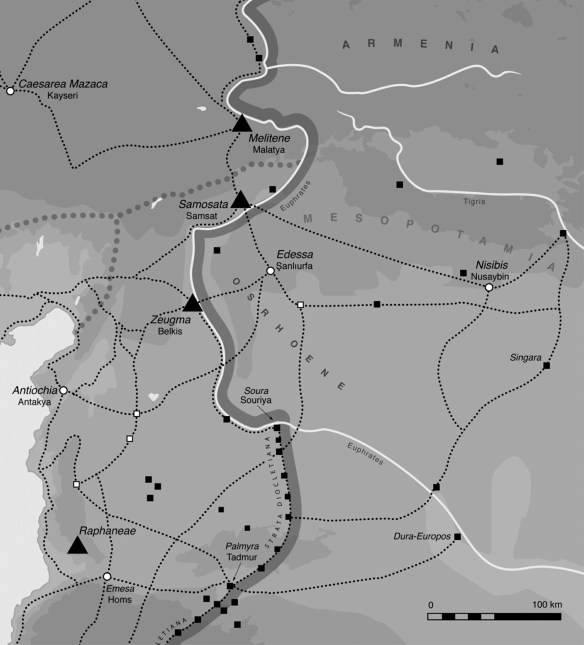The fort at Hân al-Manqoûra (Syria) from the air.
Map of the northern section of the eastern frontier in Cappadocia and Syria.
To turn from the Occident to the Orient is to enter a new world. Here, Rome took over long-established kingdoms and inherited their frontiers. Equally significantly, she faced a dangerous foe, the only other major power which bordered the empire, Parthia. Much of Rome’s relationship with her neighbour was governed by peace treaties and a wary understanding of each other’s power. The route to Parthia lay across and down the River Euphrates, and for most of the first and second centuries this river formed the boundary between the two states.
The point where the two empires were conjoined was comparatively narrow. In the time of Augustus and for the next 200 years, Rome and Parthia met for a distance of only about 260km (155 miles) along the River Euphrates from Armenia to the north to the Syrian Desert to the south. In the desert there was little room for manoeuvre so the frontier remained static, but to the north, there was a continuous tussle to control the strategically located kingdom of Armenia lying to the north of the Parthian empire and east of the Roman province of Cappadocia.
Following the conquest of the Seleucid kingdom based on Syria and later Egypt, legions were maintained in the new provinces. Troops stationed in Judaea were concerned with internal security rather than with any external threat, as in Egypt. Syria was a different matter. It was the bulwark against Parthia. Augustus based four legions, supported by auxiliary units, within the province, including at the capital Antioch, athwart the main route into – and out of – Parthia. The area between Roman Syria and the Black Sea was left to be controlled by the resident client kings who undertook the work of defence on behalf of the empire. They defended not only their section of the frontier but, on demand, supplied troops to operate with the Roman legions, as attested from Augustus to Vespasian. These client kingdoms, however, were gradually incorporated into the empire as their kings died or Roman emperors decided. By the time of Trajan the process was complete. The legions were all now on the River Euphrates, and spread more evenly than in previous years along the frontier, yet still controlling the access routes to Parthia. Two legions lay in Syria, at Zeugma/Belkis and Samosata/Samsat facing Parthia and two in Cappadocia to the north, at Melitene/Malatya and Satala/Kelkit opposite Armenia. The southern three guarded routes across the river, routes which allowed passage not only for caravans but also for armies, while the fourth lay at the southern end of the Zigana Pass leading to the Black Sea. While the Euphrates might have formed the frontier, it cut through the mountains of Cilicia and in places the resulting gorge was 3,000m (10,000ft) deep, a formidable obstacle in its own right.
There is little more that can be said about this frontier. At least fifteen auxiliary regiments are known to have been based in Cappadocia in the middle of the second century and about twice that number in Syria, but the bases of these units are generally not known.
This frontier came under significant threat from the Parthians in the second century, as will be discussed below. The Upper Euphrates from Melitene/Malatya to Satala/Kelkit and thence northwards to the Black Sea remained the frontier, but further south Rome pushed forward into the desert, and this will also be considered below. The Euphrates remained a significant line of communication and on its southern bank sat the great oasis city, and Roman garrison, of Dura-Europos. Excavations between World Wars I and II led to the identification of the military quarter in the city, the only eastern site where this arrangement has been recognized and planned.
